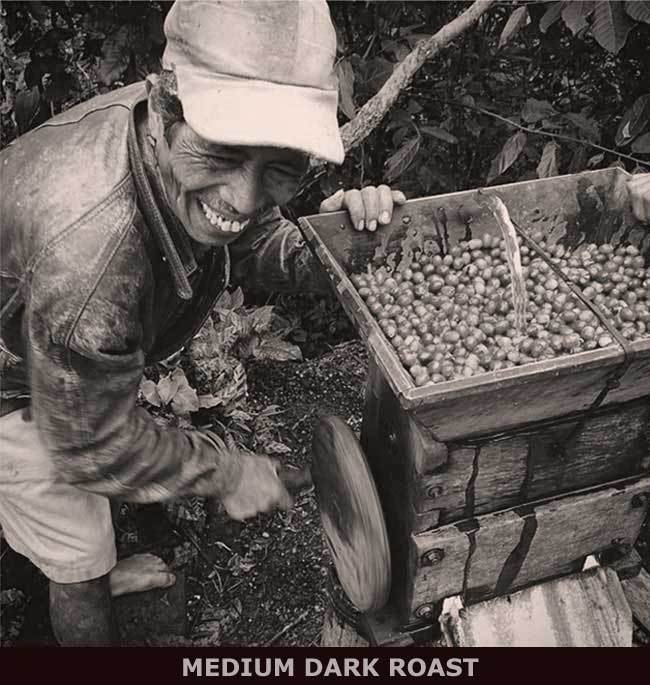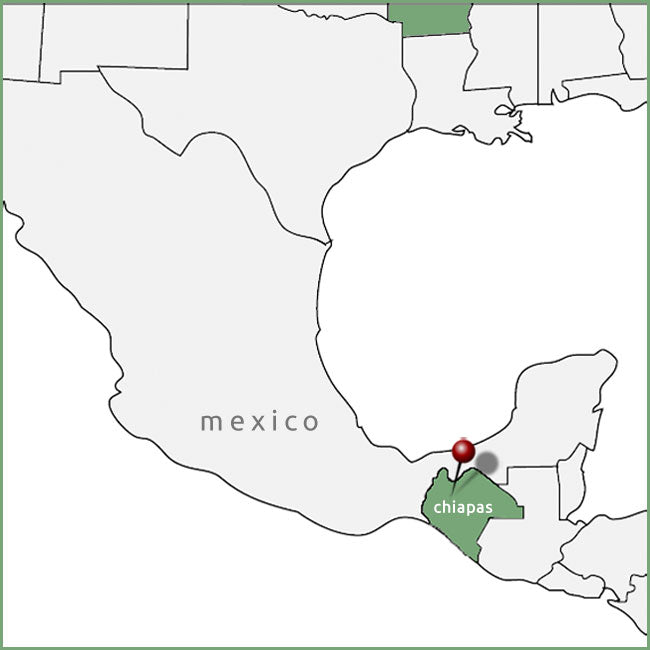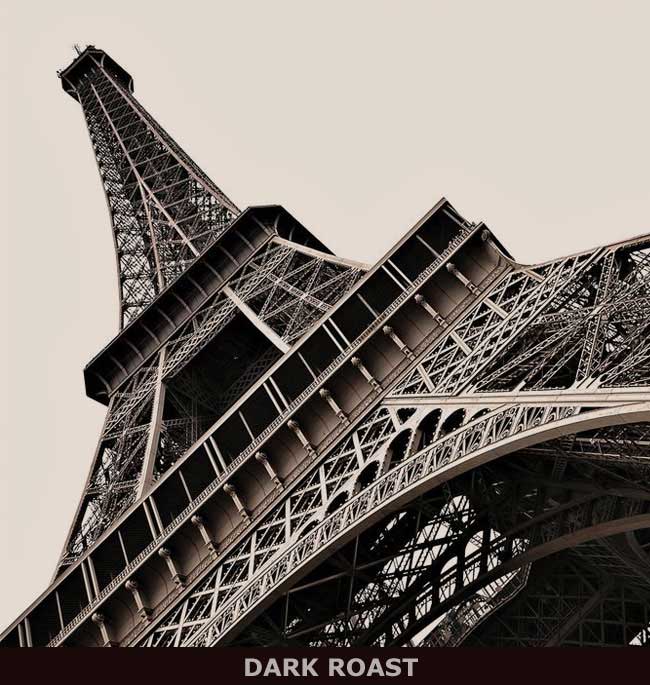Mexican Topacio Chiapas
$18.00
-
Topacio is grown by small producers located in regions of Jaltenango and Villacorzo Chiapas in Mexico. Between the January and April harvest, they hand-pulp their coffee and ferment it in small tanks before sun-drying. The majority of coffee production in this area is dominated by small producers with an average farm size of 1,5 hectares with Bourbon and Arabic Tipica trees. Several microclimates with heavy humidity give the coffee in this region a good acidity and nice body.
This region's volcanic soil and a combination of sunlight, temperature, and precipitation provide the essential components for growing Strictly High Grown coffee. Some say this is where Mexico´s best coffee can be found.
-
Cupping Profile
Tasting Notes: Chocolate, Caramel, Citrus Body: Smooth Acidity: Bright Brew Methods:  French press (coarse grind)
French press (coarse grind)
 Auto Drip (medium grind)
Auto Drip (medium grind)
 Pour Over (medium-fine grind)
Pour Over (medium-fine grind)
 Espresso (fine grind)
Espresso (fine grind)
-
Origin Information
Country: Mexico Region: Chiapas Elevation: 900 - 1100 m.a.s.l. Harvest: December - March Cultivar: Bourbon, Typica, Caturra, Catuaí Process: Fully Washed, Patio Dried -
Medium Dark Roast • Agtron 45

Agtron numbers are precise, industry standard representations of the degree of roast.
The lower the number, the darker the roast.
-
Acidity
Acidity, used as a coffee term, refers to bright, tangy, fruity, or wine-like flavor characteristics found in many high grown Arabica coffees.
Body
The physical mouth feel and texture of a coffee. Full bodied coffees have a strong, creamy, and pleasant, mouth feel. A coffee's body (light, medium, or full) is its thickness due to the amount of dissolved and suspended solids and oils extracted from the coffee grounds, and may range from thin and watery to thick and creamy.
Aroma
Coffee aroma is the fragrance of brewed coffee and is closely related to coffee flavor. Without our sense of smell, the taste is limited to the tongue senses of sweet, sour, salty, and bitter. Many nuances of coffee are in its scent, or "the nose." Coffee aroma is experienced after drinking the coffee when vapors drift upward into the nasal passage. This "retro-nasal" aroma is responsible for much of a coffees aftertaste.
Customer Reviews
Customer Reviews
Related Items
French Roast Blend
$18.00
-
French Roast is a blend of Central American and Indonesian coffees. The Central American beans provide the initial bright, pleasant acidity, and the Indonesian bean offers a beautiful earthiness that lingers on the palate. The dark roast adds caramelization that enhances the natural sugars in the coffee without over-sweetening.
This has been our most popular offering for many years. If you like a traditional coffee, this is for you.
-
Cupping Profile
Tasting Notes: Chocolate, Caramel, Orange Body: Full Acidity: Bright Brew Methods:  French press (coarse grind)
French press (coarse grind)
 Auto Drip (medium grind)
Auto Drip (medium grind)
 Pour Over (medium-fine grind)
Pour Over (medium-fine grind)
 Espresso (fine grind)
Espresso (fine grind)
-
Origin Information
Country: Costa Rica, Guatemala, and Sumatra Region: Varies Elevation: Varies Harvest: Varies Cultivar: Caturra, Bourbon, Typica, Catuaí, Giling Basah Process: Varies -
Dark Roast • Agtron 38

Agtron numbers are precise, industry standard representations of the degree of roast.
The lower the number, the darker the roast.
-
Acidity
Acidity, used as a coffee term, refers to bright, tangy, fruity, or wine-like flavor characteristics found in many high grown Arabica coffees.
Body
The physical mouth feel and texture of a coffee. Full bodied coffees have a strong, creamy, and pleasant, mouth feel. A coffee's body (light, medium, or full) is its thickness due to the amount of dissolved and suspended solids and oils extracted from the coffee grounds, and may range from thin and watery to thick and creamy.
Aroma
Coffee aroma is the fragrance of brewed coffee and is closely related to coffee flavor. Without our sense of smell, the taste is limited to the tongue senses of sweet, sour, salty, and bitter. Many nuances of coffee are in its scent, or "the nose." Coffee aroma is experienced after drinking the coffee when vapors drift upward into the nasal passage. This "retro-nasal" aroma is responsible for much of a coffees aftertaste.
Brewed Awakening
$18.00
-
Arrgh!! Waking up.
For many of us, it’s the biggest struggle of our day.
There’s no realization more unpleasant than the one that hits you when your alarm goes off, and you know you have to get out of your warm, cozy bed.
We can help.
Light roasted coffee has more caffeine than dark roasts, so we use our most popular blend and throttle back the roaster. As a result, you get more caffeine in your cup, and each sip will make you feel more alert, focused, happy, and energetic – we promise (fingers crossed).
-
Cupping Profile
Tasting Notes: Honey, Sweet, Clean, Peanut Body: Full Body Acidity: Sharp Brew Methods:  French press (coarse grind)
French press (coarse grind)
 Auto Drip (medium grind)
Auto Drip (medium grind)
 Pour Over (medium-fine grind)
Pour Over (medium-fine grind)
-
Origin Information
Country: Costa Rica, Guatemala, and Sumatra Region: Varies Elevation: Varies Harvest: Varies Cultivar: Caturra, Bourbon, Typica, Catuaí, Giling Basah Process: Varies -
Medium Roast • Agtron 53

Agtron numbers are precise, industry standard representations of the degree of roast.
The lower the number, the darker the roast.
-
Acidity
Acidity, used as a coffee term, refers to bright, tangy, fruity, or wine-like flavor characteristics found in many high grown Arabica coffees.
Body
The physical mouth feel and texture of a coffee. Full bodied coffees have a strong, creamy, and pleasant, mouth feel. A coffee's body (light, medium, or full) is its thickness due to the amount of dissolved and suspended solids and oils extracted from the coffee grounds, and may range from thin and watery to thick and creamy.
Aroma
Coffee aroma is the fragrance of brewed coffee and is closely related to coffee flavor. Without our sense of smell, the taste is limited to the tongue senses of sweet, sour, salty, and bitter. Many nuances of coffee are in its scent, or "the nose." Coffee aroma is experienced after drinking the coffee when vapors drift upward into the nasal passage. This "retro-nasal" aroma is responsible for much of a coffees aftertaste.
Bistro Blend
$18.00
-
Our French Roast in a new guise. The same components, but the proportions skew toward the brighter Central American beans. The Indonesian coffee with its beautiful earthiness is still there but just a bit lighter on the palate.
If you like our French Roast, this is a viable alternative if you crave a new experience.
-
Cupping Profile
Tasting Notes: Chocolate, Caramel, Orange Body: Full Acidity: Bright Brew Methods:  French press (coarse grind)
French press (coarse grind)
 Auto Drip (medium grind)
Auto Drip (medium grind)
 Pour Over (medium-fine grind)
Pour Over (medium-fine grind)
 Espresso (fine grind)
Espresso (fine grind)
-
Origin Information
Country: Costa Rica, Guatemala, and Sumatra Region: Varies Elevation: Varies Harvest: Varies Cultivar: Caturra, Bourbon, Typica, Catuaí, Giling Basah Process: Varies -
Dark Roast • Agtron 35

Agtron numbers are precise, industry standard representations of the degree of roast.
The lower the number, the darker the roast.
-
Acidity
Acidity, used as a coffee term, refers to bright, tangy, fruity, or wine-like flavor characteristics found in many high grown Arabica coffees.
Body
The physical mouth feel and texture of a coffee. Full bodied coffees have a strong, creamy, and pleasant, mouth feel. A coffee's body (light, medium, or full) is its thickness due to the amount of dissolved and suspended solids and oils extracted from the coffee grounds, and may range from thin and watery to thick and creamy.
Aroma
Coffee aroma is the fragrance of brewed coffee and is closely related to coffee flavor. Without our sense of smell, the taste is limited to the tongue senses of sweet, sour, salty, and bitter. Many nuances of coffee are in its scent, or "the nose." Coffee aroma is experienced after drinking the coffee when vapors drift upward into the nasal passage. This "retro-nasal" aroma is responsible for much of a coffees aftertaste.
nuJava Coffee Company
409 West Van Buren, Eureka Springs, Arkansas
Purveyor of Retail, Wholesale, and Restaurant Coffee
© 2025 nuJava Coffee Company.









